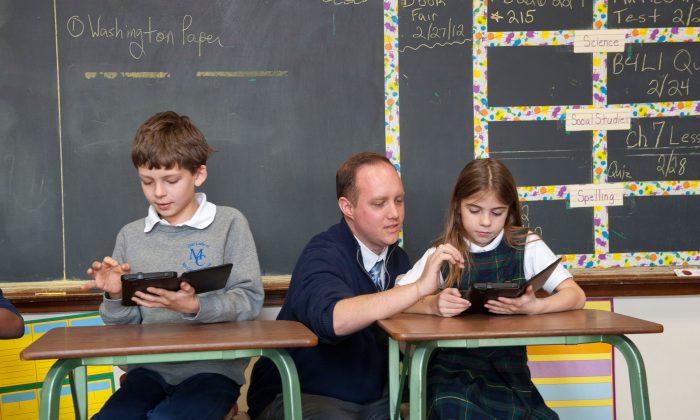NEW YORK—On a perfect, cloudless, summer day the windowless halls of Murray Bergtraum High School for Business Careers was filled with hundreds of students, administrators, technology experts, and teachers.
Gathered for a daylong technology summit on July 31 largely geared toward vendors selling their classroom products, attendees listened attentively to five-minute presentations by corporate executives in the school’s auditorium.
“We need to find a way to go out and embrace IT—ultimately build platforms where people can learn and achieve greater results,” said Tom Murphy, CMO of Bradford Networks, which creates secure network access for corporate issued and personal mobile devices. In the presentation, and in general, the company is among those pushing an initiative called B.Y.O.D. (Bring Your Own Device) for K–12.
Largely used in corporate and business settings, the concept of B.Y.O.D. (also known as Bring Your Own Technology) has started gaining some traction in the education field, but is still not widely used, particularly in New York City.
The tendency to shy away from the practice, which is predicated on students first having their own iPad, laptop, or smartphone that they bring to and from school, is evident at the top of the city’s educational system.
“I am out of my league as far as technology is concerned,” said schools Chancellor Dennis Walcott in a brief appearance at the summit, which was sponsored by the Department of Education’s Division of Instructional and Information Technology, before the tech sector presentations.
Walcott went on to say that part of what keeps him motivated as chancellor is finding new ways to make sure students get to the next level and that school is interesting.
“That’s what this is about,” he said. “Talking about the role of technology and how that gets integrated into the school system.”
Though Walcott made no mention of B.Y.O.D., it could become a hot topic for the next person who holds his position.
Dubbed a “movement” by many advocates, a July 25 Forbes article said that in the business world about 40 percent of enterprise organizations expect to eventually stop providing devices to employees. Similar predictions are difficult to make about schools, though there are some that practice B.Y.O.D. already.
Among them is High Tech High School in North Bergen, N.J. The school blog states that it is “progressive about our technology” and offer free Wi-Fi for students who use the B.Y.O.D. program and want to access the Internet with their personal devices. Pinelands Regional High School in Little Egg Harbor Township, also in New Jersey, has instituted the practice as well.
Dennis Guidera, a regional K–12 representative with Steelcase, which sells everything from American-made software to high-functioning furniture, said that technology in the classroom creates a more dynamic environment, which ultimately makes for better learning. He added that whether you agree with the trend or not, there’s no turning back.
“You’re not going to ever get away from it,” said Guidera, who was demonstrating his company’s products at the summit.
But the lack of adaptation of B.Y.O.D. in New York City, which is used in states beyond New Jersey including Florida, Texas, and Georgia, speaks to some of the significant drawbacks it poses. That includes network access, questions about how to deliver existing applications, how to access existing network storage, security, and acceptable use policies.
One upside of B.Y.O.D. for public schools like High Tech and Pinelands in New Jersey is that there is no additional cost to the school district for the devices. But then there’s the question of how students who can’t afford a device would fare in a classroom where others are logging on to get information.
“There’s a generational digital divide, and there’s the demographic divide,” said John McCabe, a commercial and education account manager for Epson, who was demonstrating his company’s digital ink whiteboard at the Wednesday summit.
Ironically, the school where the summit was held had a clearly posted sign noted that “you could lose your hats and electronics until the last day of school,” highlighting a common zero-tolerance policy for electronics of any kind in many New York City schools.
Other schools don’t have strict prohibitions, though they don’t push a B.Y.O.D. policy, either.
Four seniors from Chelsea High School at the summit said that they are allowed to bring their phones to school, but there is no blanket requirement for having devices on hand for learning purposes.
“They let you use it if you bring it,” said Masum Ahmed, a 17-year-old senior at Chelsea. “There’s no ground rule that you can’t.”





Friends Read Free